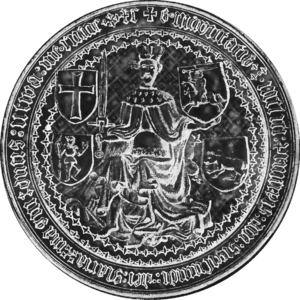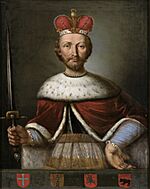Sigismund Kęstutaitis facts for kids
Sigismund Kęstutaitis (born around 1365 – died March 20, 1440) was an important leader known as the Grand Duke of Lithuania. He ruled from 1432 until his death in 1440. His Christian name was Sigismund, but his original Lithuanian name from birth is not known. He was the son of Kęstutis, who was also a Grand Duke of Lithuania, and his wife Birutė.
Contents
Early Life and Challenges
Sigismund faced many difficulties early in his life. After his father Kęstutis died, Sigismund was held prisoner by Jogaila from 1382 to 1384. In 1383, he became a Catholic.
In 1384, he managed to escape and joined his brother Vytautas. At that time, Vytautas had formed an alliance with the Teutonic Knights, a powerful military order. Later, when Vytautas teamed up with the Teutonic Knights again to fight against Skirgaila, Sigismund and his family were held as hostages by the Knights from 1389 to 1398.
Becoming a Duke
Sigismund eventually became a duke himself. He was the Duke of Navahrudak from 1390 to 1440, and also the Duke of Starodub starting in 1406. He took part in major battles, including the Battle of Vorskla and the famous Battle of Grunwald.
After his brother Vytautas passed away, Sigismund first supported his cousin Švitrigaila in a conflict against Poland. However, some important nobles later convinced Sigismund to join a plan against Švitrigaila.
Grand Duke of Lithuania
On September 1, 1432, Sigismund officially became the Grand Duke of Lithuania. He signed an agreement called the Union of Grodno with Jogaila. As part of this agreement, he gave some areas in Volhynia and Podolia to Poland.
However, Švitrigaila was still a threat and had the support of many nobles who followed the Eastern Orthodox Christian faith. To gain more support, Sigismund made an important decision in 1434. He issued a special privilege, or right, for Eastern Orthodox nobles. This privilege made their rights equal to those of Catholic nobles. He promised that no noble, no matter their religion, could be put in prison or punished without a court order. This was a big step and helped develop the feudal system in the region.
Victory and Final Years
Sigismund's army achieved a major victory over Švitrigaila in the Battle of Wiłkomierz on September 1, 1435. The Livonian Order, which was an ally of Švitrigaila, also suffered a huge defeat in this battle.
After making his position stronger in Lithuania, Sigismund tried to reduce his ties with Poland. Between 1438 and 1440, he talked with Albert of Hungary, who was also the German king, about forming an alliance against Poland. However, Sigismund was killed by supporters of Švitrigaila, possibly led by Alexander Czartoryski, at the Trakai Peninsula Castle on March 20, 1440.
Sigismund had one son named Michael Boleslaw, who died before February 10, 1452.
See also



